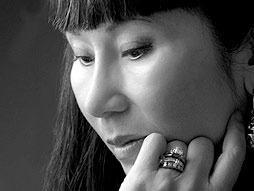Imagine it’s not your best day. Maybe you’re wearing sweatpants or don’t want to hold doors open for people or even say something to the guy who walks right into you.
Now imagine being reprimanded for those things – not in the sense that someone says something back to you, but actually reprimanded. It’s noted in your record and you’re expected to correct it. If the action persists, you’ll be sent off to a holding area designed for people just like you. Got it?
Good. Now you’re on Bitch Planet.
Pro tips for SF/F writers interested in Native themes...
Some reflections on the possibilities, pitfalls, stakes, and responsibilities of writing about Indigenous people in various genres, especially speculative fiction. By Daniel Heath Justice (Cherokee Nation citizen), fantasy novelist, Indigenous literature scholar, and cultural historian living on unceded Musqueam territory on the west coast of the lands claimed by Canada. Lifelong learner born and raised outside the Nation. @justicedanielh; imagineotherwise.ca.
Just finished reading my mystery book from Malaprop's!
One last paper proof....
Found this on tumblr & loved it. My MBTI + Harry Potter aesthetic.
aesthetically-pleasing-trashcan:
× INFP × Slytherin × Cancer × Aesthetic
The Humiliating Practice of Sex-Testing Female Athletes
No governing body has so tenaciously tried to determine who counts as a woman for the purpose of sports as the I.A.A.F. and the International Olympic Committee (I.O.C.). Those two influential organizations have spent a half-century vigorously policing gender boundaries. Their rationale for decades was to catch male athletes masquerading as women, though they never once discovered an impostor. Instead, the athletes snagged in those efforts have been intersex women — scores of them.
The treatment of female athletes, and intersex women in particular, has a long and sordid history. For centuries, sport was the exclusive province of males, the competitive arena where masculinity was cultivated and proven. Sport endowed men with the physical and psychological strength that “manhood” required. As women in the late 19th century encroached on explicitly male domains — sport, education, paid labor — many in society became increasingly anxious; if a woman’s place wasn’t immutable, maybe a man’s role, and the power it entailed, were not secure either.
Learn How Comic Book Artists Use Color as Subtext
Spatterings of red in a muted color field. Panel from Pretty Deadly #1, by Kelly Sue DeConnick, illustrated by Emma Rios, colors by Jordie Bellaire. Screencap via
Second only to the inker for the “most misunderstood job in the comics business,” the colorist has the ability to either completely enhance or deflate the mood of a comic with their work. In this week’s edition of comics masterclass Strip Panel Naked, Hass Otsmane-Elhaou looks at Jordie Bellaire’s color work in Pretty Deadly #1, written by Kelly Sue DeConnick. According to Otsmane-Elhaou, color work in comics isn’t just about “naturally coloring the world around the linework in the book. There’s a lot you can say or do with your choice of palette, and so I wanted to take a look at how Jordie Bellaire does more than just ‘color in’ Emma Rios’ linework in Pretty Deadly. I wanted to show how she, crucially, adds more to the story and theme and subtext of the book, things that wouldn’t exist without her input.”
The same clouds give off different vibes in different panels. Panels from Pretty Deadly #1, by Kelly Sue DeConnick, illustrated by Emma Rios, colors by Jordie Bellaire. Screencap via
“A colorist is an artist like any other role,” says Otsmane-Elhaou, “like the letterer, the writer, the penciller, whatever. So yes, the role is to add color and effects to the linework, but really you’re making a series of choices in how you want an audience to perceive the world, or the characters. If you rendered a whole page in blue tones, for example, it would create a calming, colder effect than if you did that whole page in shades of red.”
Otsmane-Elhaou says the coloring of Jordie Bellaire works so well because of the way she limits herself and her palette. “If you have a million colors to choose from—as colorists do—and you use them all, they all start to lose meaning,” explains Otsmane-Elhaou. “If you reduce that number to a limited selection, it allows you to tell your audience ‘this is our color space.’ Once they understand that, you can start breaking those rules, and throwing in new colors to really create a huge impact. I really love when artists do that.”
For other instances of amazing color work in comics, Otsmane-Elhaou recommends Dave Stewart’s work on Hellboy in Hell, and, of course, “anything at all by Jordie Bellaire. Honestly.”
Watch this week’s Strip Panel Naked below to see how Bellaire utilizes restricted palettes and surprising pops of color.
Catch up on your classwork with earlier episodes on the Strip Panel Naked YouTube channel.
Related:
On Panel Density: Comic Book Class Is Back in Session
The World’s First Computer Programmer Becomes a Comic Book Superheroine
from The Creators Project RSS Feed http://ift.tt/29iBlmO
via IFTTT
Grant Snider is one of my favorite cartoonists.
Conflict in Literature
OMG, this is actually the most useful explanation I have ever encountered.
Sisterhood of the Skateboard
Early one evening in June, River Avenue Skate Park in the Bronx was reverberating with its usual medley of screeching from the elevated No. 4 train and scattered applause from Yankee Stadium, when a young boy shouted, “Brujas coming, yo!”
Holy hell, what a rad story.
Where Does Creativity Hide? Amy Tan's TEDTalk
Wanted to post something inspirational today, and this 2008 TEDTalk from novelist Amy Tan is a perfect way to reflect on the evolution of the writing process and on the personal meanings of creativity.






